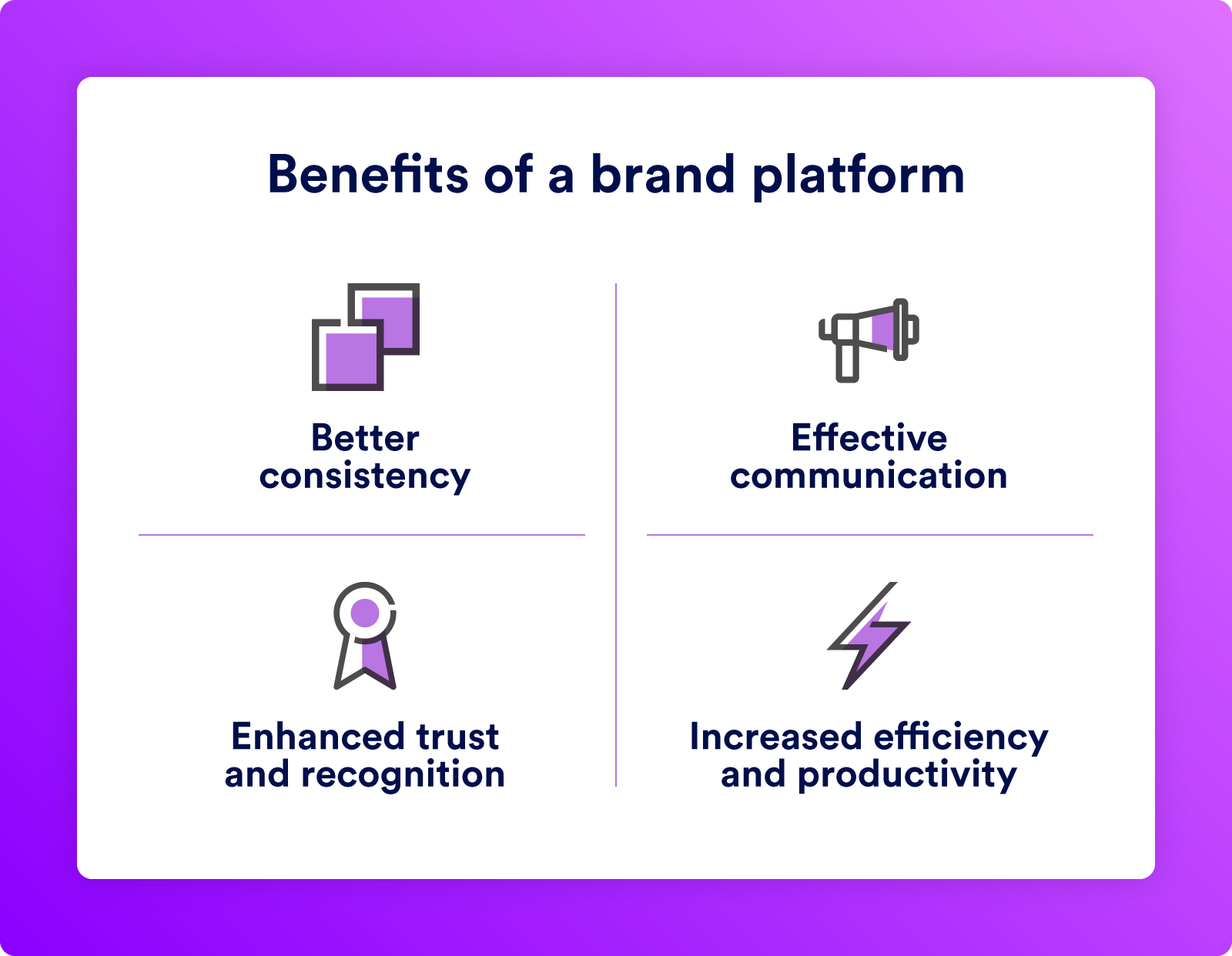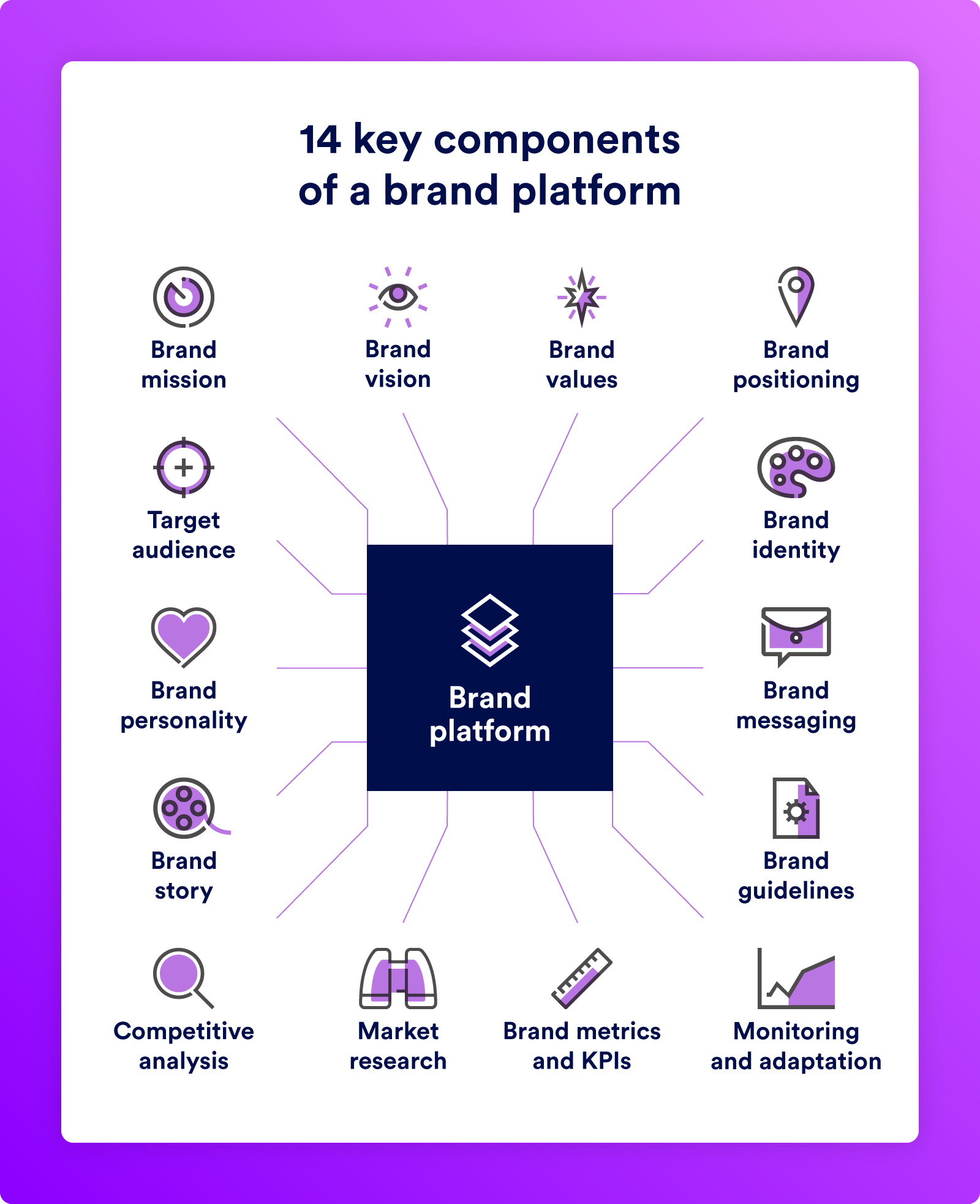Get branding tips and expert advice delivered straight to your inbox.
In a world filled with brands competing for attention, what sets one brand apart from the rest? It’s not just about having a great slogan or a visually appealing logo. It’s a carefully crafted masterpiece: a brand platform.
This secret ingredient is what turns a business into a brand. In this post, we’ll cover what a brand platform is, its importance, and 14 key components of a brand platform to help you create your own.
What Is a Brand Platform?
A brand platform is both a document and a strategy that serves as the guiding framework for how a brand presents itself to the world. It encompasses a set of guidelines that define aspects of the brand like its identity, mission, vision, values, and positioning.
A brand platform functions as a tool for maintaining brand consistency and alignment across all aspects of the brand. By adhering to the principles outlined in this framework, businesses can establish a recognizable brand that resonates with their target audience while fostering trust and loyalty.
Why Is a Brand Platform Important?
Having a brand platform is crucial, as it contributes significantly to the success of a brand. Let’s explore what makes it so important.

Consistency and Cohesion
A brand platform serves as the guiding principle for how a brand should be presented to the world. This includes defining the elements (logos, colors, typography) and the messaging (tone, style, messages).
Without a brand platform in place, you risk inconsistency in how your brand is portrayed across different touchpoints, which can confuse consumers and weaken the impact of the brand.
Effective Communication
A brand platform facilitates communication by providing clear guidance on how a brand should interact with both internal and external stakeholders. Project managers who work within this framework can ensure that project teams, clients, and partners all speak the same language when it comes to representing the brand.
This reduces misunderstandings and enhances collaboration. It also allows project managers to tailor their communication strategies to align with the brand’s identity and values, ultimately strengthening brand perception.
Brand Trust and Recognition
Establishing a brand platform is crucial for building trust among consumers. When a brand consistently reflects its core values and fulfills its promises, it becomes more reliable, leading to increased customer trust.
A brand platform also plays a role in promoting brand recognition. When people repeatedly encounter the elements and messaging associated with a brand, they become more familiar with it, making the brand more memorable and easily recognizable.
Efficiency and Productivity
A comprehensive brand platform streamlines the creation of marketing materials, project documents, and other deliverables. This helps increase efficiency and productivity by reducing the time spent on decision-making about these deliverables. For project managers specifically, this increased efficiency means they can focus on delivering high-quality results while meeting deadlines on branding-related projects.
14 Key Elements of a Brand Platform
Creating a brand platform involves defining and shaping various elements that serve as the pillars of a brand’s identity and messaging. By developing these components, brands can establish identities that resonate with their target audience, ultimately driving their success.

1. Brand Mission
A mission statement is the guiding principle that outlines the goal of a brand and the reason for its existence. Having a mission statement is crucial for a brand platform because it defines the overall purpose of the brand and the value it aims to offer.
Your mission statement guides your brand’s identity and goals. Because your mission statement is a foundational element of your brand platform, prioritize it early in your branding journey. Get a head start with one of these mission statement templates.
2. Brand Vision
A brand’s vision statement creates an image of its long-term goals. It’s more than a statement; it builds a narrative that encourages consumers to rally behind the cause.
Let’s take Whole Foods’ vision statement as an example: “To nourish people and the planet.” This particular vision is tailored to resonate with its target audience, who are passionate about health and sustainability.
The brand vision plays a role in defining a brand platform because it guides the brand’s long-term goals, influences strategic decisions, and motivates stakeholders. By aligning everyone with a shared vision, it helps drive the brand’s purpose.
3. Brand Values
Brand values are the principles that shape a brand’s identity and guide its actions and choices. They impact the brand’s culture, relationships, and trustworthiness, defining its character and integrity in the market.
Brand values are important to a brand platform, as they act as a compass that supports the brand’s actions, ensuring consistency and integrity in both its messaging and behavior. These elements form the foundation for the brand’s identity and purpose, guaranteeing that its actions align with its core beliefs.
4. Brand Positioning
Brand positioning determines where a brand sits compared to its competitors in the market. It entails carving out a unique space for the brand, developing its unique selling points to give it a competitive edge and resonate with the audience’s needs.
Brand positioning is a necessary aspect of any brand platform, as it clearly defines where the brand stands compared to competitors. This establishes a brand presence that resonates with the target audience while ensuring consistency and alignment across all brand projects and activities.
5. Target Audience
Understanding the intended audience plays a major role in brand strategy. It involves identifying the demographics, psychographics, and behaviors that define a brand’s target customers. This understanding of the audience helps develop customer profiles, craft brand messaging, and create marketing materials that effectively resonate with the target market.
By knowing who their target audience is, what they want, and how they think, brands can produce content, products, and experiences that are relevant and that genuinely connect with their customers. This understanding of the target audience forms the foundation of branding and project management by ensuring efforts are directed toward the right people in the right way.
6. Brand Personality
Brand personality is the humanized representation of a brand. It encompasses characteristics and traits associated with the brand to make it relatable and memorable for its audience. This personality influences how the brand communicates its tone, style, and overall approach to engage with customers.
Is it friendly and approachable like Chewy? Upscale like Rolex? Perhaps daring and innovative like Tesla? These personality traits shape how a brand speaks, behaves, and interacts with its valued customers.
By giving a brand that human touch, customers can emotionally connect with it, strengthening their loyalty and involvement. A brand’s personality plays a role in defining the brand’s identity and helping it resonate with the target audience.
7. Brand Story
The brand story is the narrative that tells the brand’s history, from start to present. It adds a relatable element to the brand platform, establishing a connection with its audience. Crafting a brand story provides insights into the challenges faced, milestones achieved, and values that shape the brand’s essence.
This foregrounds a human angle and fosters an authentic bond with customers. The brand becomes more than just a name — it becomes an engaging entity people can relate to.
8. Brand Identity
Brand identity includes the elements that represent the brand, like logos, color schemes, typography, and design guidelines. Ensuring consistency in these elements across all materials and touchpoints is crucial for creating cohesiveness and instant recognition for the brand.
Whether it’s including a logo in a project report or using brand colors during a presentation, these elements play a role in establishing a brand presence that reinforces recognition and trust.
9. Brand Messaging
Brand messaging forms the essence of a brand. It encompasses the messages, taglines, and communication style that effectively convey the brand’s values and purpose to its target audience.
Consistency in messaging is paramount: a brand should maintain the same voice across all assets. Whether it’s creating a project proposal or interacting with customers, brand messaging acts as the guiding light, helping teams understand what to say and how to say it.
10. Brand Guidelines
Brand guidelines serve as the rulebook for maintaining consistency across projects. They provide instructions on how to use and implement visual assets and brand messaging. These guidelines address logo placement, color codes, font choices, tone of voice, and more, and they serve as a reference for representing the brand.
Essentially, brand guidelines are a project manager’s best friend, as they provide a clear roadmap for incorporating the brand into all project materials. To compile your brand assets into a cohesive brand platform, try one of these brand guidelines templates.
11. Competitive Analysis
To position a brand effectively, it’s crucial to understand the competitive landscape. This involves conducting research on the strengths, weaknesses, market presence, and strategies of competing brands. By gaining insight into what makes competitors unique, your brand can better highlight its own selling points and identify opportunities to stand out.
Analyzing the competition also helps recognize market trends and identify gaps your brand can take advantage of. For project managers, this understanding is vital, as it enables you to tailor your projects and strategies to effectively compete in the marketplace while strengthening the brand’s position.
12. Market Research
Market research is the foundation of a company’s decision-making. It encompasses gathering data on things like target audience demographics, market trends, and consumer behaviors. By understanding the preferences and needs of their target audience through market research, project managers can develop initiatives that resonate.
Staying attuned to evolving market trends and consumer behaviors also helps you adapt to changing conditions while staying relevant. Market research acts as a roadmap for making data-driven decisions that yield results.
13. Brand Metrics and KPIs
To assess the success of a brand and the effectiveness of its initiatives, it’s crucial to establish key performance indicators (KPIs) and metrics. By monitoring these KPIs, brands can gain insight into what’s working well and which areas require improvement.
This data-driven approach ensures that projects align with the brand strategy and contribute to achieving the brand’s goals. Essentially, brand metrics and KPIs provide a way to measure success and optimize project management efforts for impact.
14. Monitoring and Adaptation
Continuously monitoring and adapting a brand platform is a part of maintaining a brand presence. These practices ensure the brand remains relevant and responsive to market dynamics and internal changes. Monitoring involves keeping track of market trends, consumer feedback, and how well the brand performs against its established KPIs and metrics.
With this information in hand, adaptation becomes crucial in allowing brands to proactively adjust their strategies and tactics. In project management, being flexible and adaptable is equally important. By integrating monitoring and adaptation into their approach, brands can navigate market shifts effectively while responding appropriately to changes, fostering long-term success and resilience.
Manage Your Brand Platform With Brandfolder
In the world of branding, a brand platform serves as the bedrock for success. It includes your brand’s mission, vision, values, and more, ensuring that your messaging and identity remain cohesive and impactful. A strong brand platform is essential for consistency, effective communication, and building trust and recognition.
If you’re looking to manage your brand assets and brand platform effectively, consider exploring tools like Brandfolder by Smartsheet. With Brandfolder, you can streamline the organization, distribution, and management of your brand assets, ensuring that your brand stays consistent and resonates with your audience. Check out our digital asset management software to learn how Brandfolder can help you manage your brand assets.
